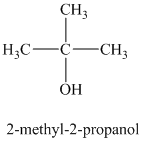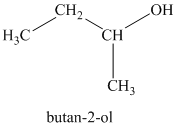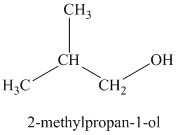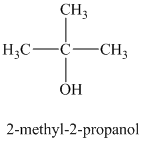
Concept explainers
dentify each of the following
NMR spectra:
Interpretation:
The structures of each of the
Concept introduction:
In
The number of signals in a spectrum gives information about the type of carbon atoms present in the structure of the compound.
In
The
Index of hydrogen deficiency (IHD) is calculated by the equation as follows:
Here,
Oxygen atoms do not disturb the index of hydrogen deficiency.
At
At
A methine is
Answer to Problem 38P
Solution: The structures of each of the
a)

b)

c)

Explanation of Solution
a)
The molecular formula shows an index of hydrogen deficiency equal to zero. Thus, the alcohol contains no ring or multiple bonds. The
The signal
The signal
The structure must contain three equivalent methyl groups and one tertiary carbon atom. Therefore, the structure of this isomer is shown as follows:

This isomer is a tertiary alcohol.
b)
The molecular formula shows an index of hydrogen deficiency equal to zero. Thus, the alcohol contains no ring or multiple bonds. The
The signal
The signal
The signal
Thus, the structure must contain two non-equivalent methyl groups, one methylene group, and one methine group to which the hydroxyl group is attached.
Therefore, the structure of this isomer is shown as follows:

This isomer is a secondary alcohol.
c)
The molecular formula shows an index of hydrogen deficiency equal to zero. Thus, the alcohol contains no ring or multiple bonds. The
The signal
The signal
The signal
Thus, the structure must contain two equivalent methyl groups, one methylene group, and one methine group to which the hydroxyl group is attached.
Therefore, the structure of this isomer is shown as follows:

Want to see more full solutions like this?
Chapter 16 Solutions
ORGANIC CHEMISTRY-PACKAGE >CUSTOM<
- Can you draw this using Lewis dot structures and full structures in the same way they are so that I can better visualize them and then determine resonance?arrow_forwardSynthesize the following compound from cyclohexanol, ethanol, and any other needed reagentsarrow_forwardFor a titration of 20.00 mL of 0.0500 M H2SO4 with 0.100 M KOH, calculate the pH at each of the following volume of KOH used in the titration: 1) before the titration begin; 2) 10.00 mL; 3) 20.00 mL; 4) 30.00 mL. Ka2 = 1.20×10-2 for H2SO4.arrow_forward
- Curved arrows are used to illustrate the flow of electrons. Using the provided starting and product structures, draw the curved electron-pushing arrows for the following reaction or mechanistic step(s) Be sure to account for all bond-breaking and bond-making steps Problem 73 of 10 Drawing Amows ro HO Donearrow_forward12. Synthesize the following target molecules (TMs) using the specified starting materials. .CI a) HO3S SM TM b) HO- SMarrow_forwardFor a titration of 20.00 mL of 0.0500 M H2SO4 with 0.100 M KOH, calculate the pH at each of the following volume of KOH used in the titration: 1) before the titration begin; 2) 10.00 mL; 3) 20.00 mL; 4) 30.00 mL. Ka2 = 1.20×10-2 for H2SO4.arrow_forward
- Write the systematic name of each organic molecule: structure name show work. don't give Ai generated solutionarrow_forwardShow work with explanation needed. Don't give Ai generated solutionarrow_forwardA Elschboard Part of SpeechT-D Alt Leaming App app.aktiv.com Curved arrows are used to illustrate the flow of electrons. Using the provided resonance structures, draw the curved electron- pushing arrows to show the interconversion between resonance hybrid contributors. Be sure to account for all bond-breaking and bond-making steps. Include all lone pairs and formal charges in the structures. Problem 45 of 10 I Select to Add Arrows N Please selarrow_forward
- So I'm working on molecular geometry. Can you help me with this stuff here and create three circles: one that's 120, one that’s 180, and one that’s 109.5?arrow_forwardCurved arrows are used to illustrate the flow of electrons. Using the provided starting and product structures, draw the curved electron-pushing arrows for the following reaction or mechanistic step(s). Be sure to account for all bond-breaking and bond-making steps. Problem 164 of N Select to Add Arrows CHI CH 1 1 1 Parrow_forwardusing these can you help me , I guess convert them to lewis dit structures or full drawn out skeletal and I guess is that what would help me depict the bond angle.arrow_forward
 Organic ChemistryChemistryISBN:9781305580350Author:William H. Brown, Brent L. Iverson, Eric Anslyn, Christopher S. FootePublisher:Cengage Learning
Organic ChemistryChemistryISBN:9781305580350Author:William H. Brown, Brent L. Iverson, Eric Anslyn, Christopher S. FootePublisher:Cengage Learning
 Introduction to General, Organic and BiochemistryChemistryISBN:9781285869759Author:Frederick A. Bettelheim, William H. Brown, Mary K. Campbell, Shawn O. Farrell, Omar TorresPublisher:Cengage Learning
Introduction to General, Organic and BiochemistryChemistryISBN:9781285869759Author:Frederick A. Bettelheim, William H. Brown, Mary K. Campbell, Shawn O. Farrell, Omar TorresPublisher:Cengage Learning


